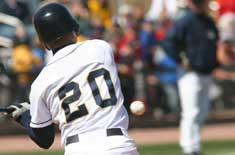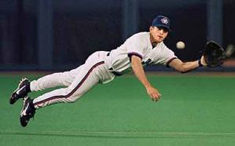
The Basic Things that Baseball and Softball Batters Do
 |
Good things a batter can do:
- Get a hit. (See below.) He is now a runner.
- Get a free walk to first base, i.e. be patient and don't swing the bat while the pitcher (usually by mistake) throws four balls (not necessarily consecutively) outside of the strike zone. He is now a runner.
- Get hit by the pitched baseball—which hurts and which I have not mentioned until now. Awarded first base, he becomes a runner.
Types of "hits":
- Hit a baseball so far that it flies over the wall in fair territory. It is a homerun. The batter (and any runners in front of him) automatically scores a run.
- Hit a baseball so hard that it bounces over the wall and is judged to be a fair-ball. He is awarded possession of second base. He is now a runner.
- Hit a baseball (that is judged to be a fair-ball) and reach any base before the defense can get him out. He is now a runner.
 |
The bad thing a batter (or a runner) can do is make an out, a failure to perform.
If he makes the first or second out of the half-inning, he sits down on the bench. If he makes the third out, his whole team stops playing offense and starts playing defense. (The categories of outs are listed below.)
Types of outs:
- A strike-out, comprised of any combination of three strikes, i.e., striking at any pitch, but missing it; not striking at a pitch in the strike zone; hitting a foul-ball that no one catches before it bounces, except that a foul-ball is not counted if it would be the third strike.
- A fly-out: the defense catches any baseball, fair or foul, as it flies through the air before it makes any bounce.
- Any of a variety of base-running outs: see the section on running.



